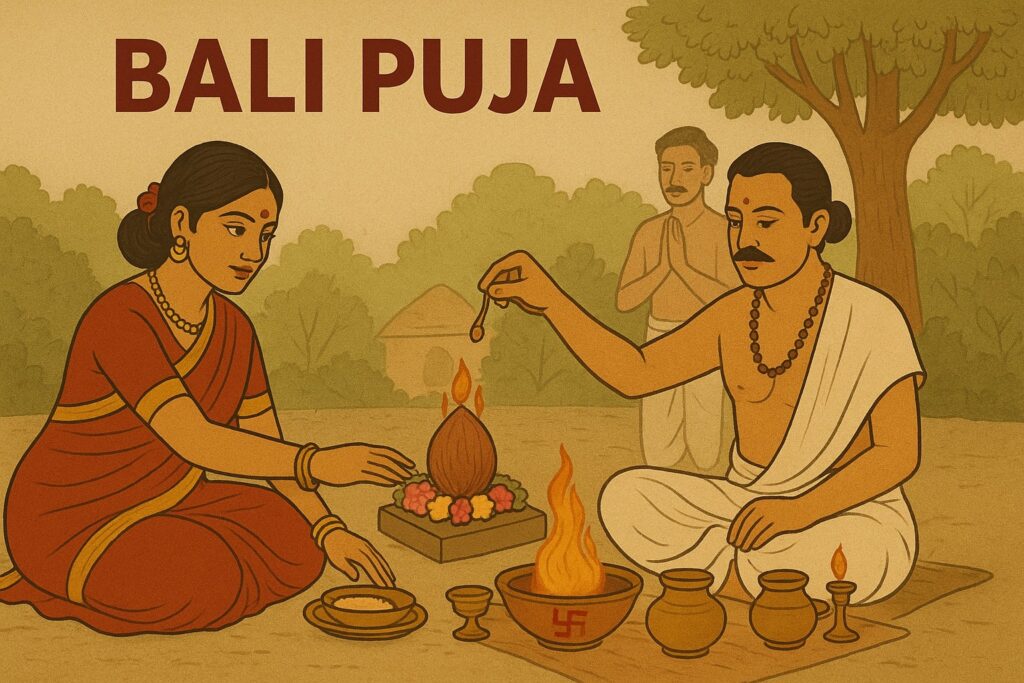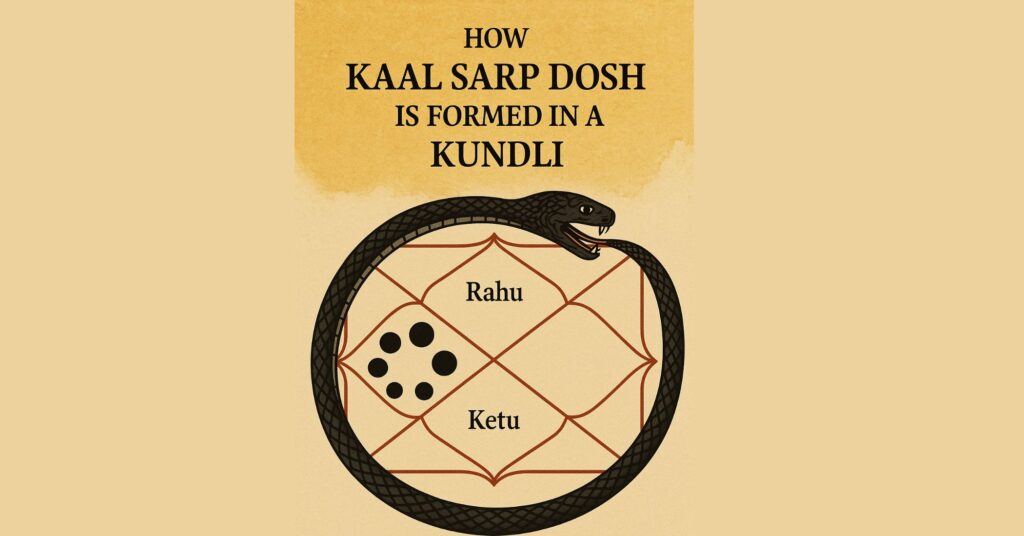Hinduism has strong roots in rituals and practices that bond people to the divine, ancestors, and universal energies. Such a potent ritual is Bali Puja, an offering ritual done to placate ancestors (Pitru Devatas), gods, and universal energies. Bali in Hinduism means “sacrifice” or “offering,” identifying the devotee’s submission and appreciation to the supreme powers.
Bali Puja is of great significance in most Hindu households, particularly for breaking family curses (Pitru Dosha) and eliminating hindrances in life. Performed with faith in the hands of a learned priest, it yields peace, prosperity, and spiritual advancement.

What is Bali Puja?
Bali Puja is a sacrifice of oblations (Bali) usually prepared of rice, grains, sesame seeds, flowers, and water to the gods and forefathers. Bali Puja is a gesture of respect, gratitude, and submission to the divine forces ruling the universe.
Bali Puja, in Vedic lore, is regarded as a necessity for the balance of cosmic forces and the acquisition of blessings of ancestors. Bali Puja is done to:
Please Pitru Devatas (ancestral spirits).
Remove Pitru Dosha and karmic obstacles.
Achieve the blessings of deities for peace and prosperity.
Strengthen the human-divine force relationship.
Importance of Bali Puja
The significance of Bali Puja is that it helps restore balance in the life of the devotee. In the Garuda Purana and other scriptures, it is described that ancestors who do not have peace can bring trouble in the lives of their descendants. Bali Puja can help a person obtain forgiveness for the sins committed in the past, settle karmic accounts, and bring peace to the souls of the deceased.
Bali Puja is also associated with:
Removal of marriage and career obstructions.
Children and family prosperity blessings.
Release from inherited curses.
Achieving spiritual growth.
When is Bali Puja Performed?
Bali Puja is routinely performed during:
Pitru Paksha (Shraddha fortnight)
a holy period devoted to forefathers.
Amavasya (New Moon)
When ancestral power is thought to be at its peak.
On special family events like the initiation of a new house, business, or marriage, in order to acquire the forefathers’ blessings.
Procedure of Bali Puja
Bali Puja is done as per Vedic rituals and takes a few hours. The key procedures are:
Sankalp (Resolution)
The worshipper makes a promise to do the puja sincerely.
Purification Rituals
Sacred bath and purification of the site and worshippers.
Invocation of Deities and Ancestors
Through mantras and prayers.
Bali Offering
Rice balls (Pindas), sesame seeds, and water are offered to ancestors, flowers, and holy grass (Kusha).
Havan (Fire Ritual)
Offerings are placed into the holy fire to appease deities and ancestors.
Tarpan (Water Offering)
Sesame seeds mixed with water and flowers is offered to ancestors.
Blessings and Prasad Distribution
The puja ends with blessings to the family for good health, prosperity, and spiritual well-being.
Advantages of Bali Puja
Bali Puja has various spiritual and worldly advantages:
1. Peace for Ancestors
The puja helps ancestors achieve peace, thus blessing the descendants with protection and prosperity.
2. Elimination of Pitru Dosha
Bali Puja is the most effective solution for Pitru Dosha, an affliction in astrology that leads to family growth, marriage, and financial obstacles.
3. Career progress in Marriage and Childbirth
The puja eliminates obstacles in marriage and assists couples who have been blessed with healthy offspring.
4. Financial Stability
Most families experience relief from debt, losses, and financial constraints following Bali Puja.
5. Family Harmony
It minimizes conflicts, misunderstandings, and quarrels and brings back harmony in the home.
6. Health Benefits
Through the removal of ancestral curses and karmic burdens, the devotees enjoy improved health and protection against unexpected diseases.
7. Spiritual Growth
The puja cleanses karmic baggage and brings the devotee closer to spiritual enlightenment.
Who Should Perform Bali Puja?
Bali Puja is recommended for:
Families suffering from Pitru Dosha.
People facing delays in marriage or childbirth.
Those experiencing repeated financial losses or health problems.
Individuals with recurring ancestral-related dreams.
Families who wish to express gratitude to their forefathers.
Best Places for Bali Puja
Bali Puja can be performed at any sacred site, but some places hold special significance:
Trimbakeshwar Jyotirlinga (Nashik, Maharashtra)
A strong point for ritual worship of ancestors.
Gaya (Bihar)
Renowned for Pitru Tarpan and Shraddha rituals.
Rameshwaram (Tamil Nadu)
Renowned for ancestor pujas.
Kashi (Varanasi)
The gateway to moksha (liberation).
Of these, Trimbakeshwar is greatly sacred as Lord Shiva, the lord of ancestors (Pitrupathi), dwells here.
Conclusion
Bali Puja is a ritual that not only brings tranquility to the ancestors but also provides prosperity, health, and peace to all members of the family. Performing this puja, devotees thank their ancestors, eliminate Pitru Dosha, and welcome divine blessings to their homes.
Of the many holy sites, Trimbakeshwar Jyotirlinga is the strongest centre for Bali Puja, Narayan Nagbali Puja, and Kaal Sarp Puja. But the efficacy of the ritual also depends significantly on the skills of the pandit performing it.
One of the most renowned priests in Trimbakeshwar is Shivendra Guru Ji, who is considered the most suitable pandit for Kaal Sarp Puja and Bali Puja. With profound knowledge in Vedic texts and years of experience, he has successfully led thousands of families towards peace and prosperity.
One of the most seasoned and reliable pandits for Bali Puja, he is renowned for conducting the rituals with full Vedic practices and dedication. Book your Bali Puja with an experienced and knowledgeable Pandit for authentic rituals and peace of mind. Contact us !
Author: Shivendra Guru Ji
For an accurate and authentic puja, Shivendra Guru Ji is the best pandit for Kaal Sarp Puja in Trimbakeshwar. With years of experience and unmatched spiritual discipline, he ensures each ritual is conducted with precision, sanctity, and divine energy.
Feel free to connect with me on Instagram, and book your Kalsarp Dosh Shanti Pooja at Trimbakeshwar Temple in Nashik with an experienced and knowledgeable Pandit for authentic rituals and peace of mind.
Bonus Tips – Best pandit for kaal sarp puja in trimbakeshwar
FAQs on Bali Puja – Significance, Procedure, and Benefits
1. How long does Bali Puja last?
The puja typically lasts 2–4 hours, depending upon the rituals.
2. Can women do Bali Puja?
Yes, women can do Bali Puja, particularly when done as a family ritual.
3. Is Bali Puja dissimilar from Shraddha?
Bali Puja is all about offerings (Bali) and fire rituals, whereas Shraddha is about feeding Brahmins and giving pindas. Both are with the aim of ancestral peace.
4. How frequently should Bali Puja be done?
It is advised to perform Bali Puja once a year, especially during Pitru Paksha.
5. How much does Bali Puja cost?
The price can be between ₹7,000 to ₹15,000 based on the temple and the magnitude of rituals.
6. Can someone else be included in the puja?
Yes, the puja can also be carried out in the name of family members by taking a sankalp.


